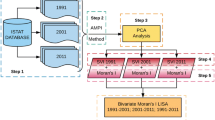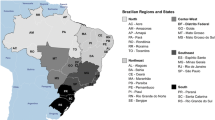Abstract
In recent decades, losses resulted from natural disasters have dramatically increased and combined with a significant rise in the intensity and frequency of natural hazards, and in exposure. China is prone to multiple hazards and has experienced huge changes in its social fabric during the past two decades, especially in its population density, development patterns, and other social characteristics. These changes may have exposed the population and society to higher risks than ever before. It is, therefore, important to identify and assess regional social vulnerability to natural hazards to strengthen decision making in disaster risk reduction planning and risk governance. To quantify regional social vulnerability to natural hazards and map its temporal–spatial distribution in China, we carefully selected variables from an extensive compilation of provincial socioeconomic and demographic data. Because of the data issue of high dimension and low sample size, we used a two-level approach to calculate social vulnerability index scores. Dynamic geographic patterns of social vulnerability were captured, and spatial autocorrelations were then calculated. The results indicated a quasi-dualistic structure of social vulnerability in China, with a higher distribution in eastern China compared with that in western China, and a declining trend in spatial clustering in recent years.




Similar content being viewed by others
References
Abdi H, Williams LJ (2010) Principal component analysis. Wiley Interdiscip Rev Comput Stat 2:433–459
Adger WN (1999) Social vulnerability to climate change and extremes in coastal Vietnam. World Dev 27:249–269
Adger WN (2006) Vulnerability. Glob Environ Change 16:268–281
Alwang J, Siegel PB et al (2001) Vulnerability: a view from different disciplines, vol 115. Social Protection Discussion Paper Series, The World Bank
Amaro H et al (2005) Racial/ethnic differences in social vulnerability among women with co‐occurring mental health and substance abuse disorders: implications for treatment services. J Commun Psychol 33:495–511
Amigo H, Bustos P (1995) Risk factors of short stature in Chilean school children from rural areas of high social vulnerability. Arch Latinoam Nutr 45:97–102
Andrew MK et al (2012) The impact of social vulnerability on the survival of the fittest older adults. Age Ageing 41:161–165
Armaş I (2008) Social vulnerability and seismic risk perception. Case study: the historic center of the Bucharest Municipality/Romania. Nat Hazards 47:397–410
Ash RF, Edmonds RL (1998) China’s land resources, environment and agricultural production. China Q 156:836–879
Bankoff G et al (2004) Mapping vulnerability: disasters, development, and people. Earthscan, UK, pp 10–37
Blaikie PC, Cannon TT, Davis I, Wisner B (1994) At risk: natural hazards, people’s vulnerability, and disasters. Disaster and society–from hazard assessment to risk reduction. Routledge, London, pp 75–82
Bolin R, Stanford L (1991) Shelter, housing and recovery: a comparison of US disasters. Disasters 15:24–34
Brandt L, Rawski TG (2008) China’s great economic transformation. Cambridge University Press, Cambridge, pp 15–23
Brooks N (2003) Vulnerability, risk and adaptation: a conceptual framework. Research working paper 38, Tyndall Centre for Climate Change, pp 1–16
Burton I (1993) The environment as hazard. Guilford Press, USA, pp 32–240
Cangelosi R, Goriely A (2007) Component retention in principal component analysis with application to cDNA microarray data. Biol Direct 2:1–21
Carter RL (2008) 2.2 Understanding resilience through ritual and religious practice: an expanded theoretical and ethnographic framework. Resilience and Social Vulnerability, Institute for Environment and Human Security, UN, pp 73–76
Clare L, Weninger B (2010) Social and biophysical vulnerability of prehistoric societies to rapid climate change. Doc Praehist XXXVII:269–284
Cutter SL (1996) Vulnerability to environmental hazards. Prog Hum Geogr 20:529–539
Cutter SL (2003) The vulnerability of science and the science of vulnerability. Ann As Am Geogr 93:1–12
Cutter SL, Finch C (2008) Temporal and spatial changes in social vulnerability to natural hazards. Proc Natl Acad Sci 105:2301–2306
Cutter SL et al (2003) Social vulnerability to environmental hazards. Soc Sci Q 84:242–261
De Risi R et al (2013) Flood risk assessment for informal settlements. Nat Hazards 69:1003–1032
Dwyer A et al (2004) Quantifying social vulnerability: a methodology for identifying those at risk to natural hazards. Geoscience Australia, Canberra, pp 2–3
Ehrlich PR, Holdren JP (1971) Impact of population growth. Science 171:1212–1217
Ellis CJ (2012) A risk-based model of climate change threat: hazard, exposure, and vulnerability in the ecology of lichen epiphytes. Botany 91:1–11
Enarson E (2000) Gender issues in natural disasters: talking points and research needs. I.I.F.P.o.C.R.a.R. Workshop. Editor, Geneva
Fekete A (2009) Validation of a social vulnerability index in context to river-floods in Germany. Nat Hazards Earth Syst Sci 9:393–403
Flanagan BE et al (2011) A social vulnerability index for disaster management. J Homel Secur Emerg Manage 8(1)
Griffith DA (1987) Spatial autocorrelation. Association of American Geographers, Washington
He B, Wu J, Lü A, Cui X, Zhou L, Liu M, Zhao L (2013) Quantitative assessment and spatial characteristic analysis of agricultural drought risk in China. Nat Hazards 66(2):155–166
Holand IS, Lujala P, Rød JK (2011) Social vulnerability assessment for Norway: a quantitative approach [J]. J Geogr 65(1):1–17
Khazai B, Merz M, Schulz C, Borst D (2013) An integrated indicator framework for spatial assessment of industrial and social vulnerability to indirect disaster losses. Nat Hazards 67(2):145–167
Kirigia JM, Sambo LG, Aldis W, Mwabu GM (2004) The burden of natural and technological disaster-related mortality on gross domestic product (GDP) in the WHO Africa Region. Afr J Health Sci 9(2):169–180
Liu X, Lei J (2003) A method for assessing regional debris flow risk: an application in Zhaotong of Yunnan province (SW China). Geomorphology 52:181–191
Liu A et al (1999) Economic growth and structural changes in employment and investments in China, 1985–94. Econ Plann 32:171–190
Martins VN, e Silva DS, Cabral P (2012) Social vulnerability assessment to seismic risk using multicriteria analysis: the case study of Vila Franca do Campo (São Miguel Island, Azores, Portugal)[J]. Nat Hazards 62(2):385–404
Mileti D (1999) Disasters by design: a reassessment of natural hazards in the United States. National Academies Press, USA, pp 17–63
Morrow BH (1999) Identifying and mapping community vulnerability. Disasters 23:1–18
Nardo M, Saisana M, Saltelli A, Tarantola S, Hoffman A, Giovannini E (2005) Handbook on constructing composite indicators: methodology and user guide (No. 2005/3). OECD Publishing, Paris
Ngo EB (2001) When disasters and age collide: reviewing vulnerability of the elderly. Nat Hazards Rev 2:80–89
Ord JK, Getis A (2001) Testing for local spatial autocorrelation in the presence of global autocorrelation. J Reg Sci 41(3):411–432
O’Reilly G et al (2006) Critical infrastructure analysis of telecom for natural disasters. IEEE on telecommunications network strategy and planning symposium, 2006 NETWORKS 2006 12th international, pp 1–6
Peduzzi P et al (2009) Assessing global exposure and vulnerability towards natural hazards: the Disaster Risk Index. Nat Hazards Earth Syst Sci 9:1149–1459
Pei F et al (2012) Assessing the impacts of droughts on net primary productivity in China. J Environ Manage 114:362–371
Pulido L (2000) Rethinking environmental racism: white privilege and urban development in Southern California. Ann As Am Geogr 90:12–40
Restrepo GO, Campis ES (2013) Culture of risk in vulnerable communities: the case of Barranquilla, Colombia, in the context of globalized (in) security. Human Ecol Risk Assess Int J 19:423–442
Saxena M (2013) A comparative study of total factor productivity of agriculture sectors in India and China: since 1970s. Dissertation, Int J Res IT Manage
Sidle R et al (2004) Interactions of natural hazards and society in Austral-Asia: evidence in past and recent records. Quatern Int 118:181–203
Snow RC (2008) Sex, gender, and vulnerability. Glob Public Health 3:58–74
Solangaarachchi D et al (2012) Social vulnerability in the context of bushfire risk at the urban-bush interface in Sydney: a case study of the Blue Mountains and Ku-ring-gai local council areas. Nat Hazards 64:1873–1898
Tate E (2012) Social vulnerability indices: a comparative assessment using uncertainty and sensitivity analysis. Nat Hazards 63:325–347
Tierney KJ et al (2001) Facing the unexpected: disaster preparedness and response in the United States. Joseph Henry Press, Washington, pp 81–116
Timmerman P (1981) Vulnerability resilience and collapse of society. A review of models and possible climatic applications. Institute for Environmental Studies, University of Toronto, Toronto
Turner BL et al (2003) A framework for vulnerability analysis in sustainability science. Proc Natl Acad Sci 100:8074–8079
Wang Z, He F, Fang W, Liao Y (2013) Assessment of physical vulnerability to agricultural drought in China. Nat Hazards 67:645–657
Webb GR et al (2000) Businesses and disasters: empirical patterns and unanswered questions. Nat Hazards Rev 1:83–90
Wylie ML (1999) Hurricane Andrew: ethnicity, gender and the sociology of disasters. Am Anthropol 101:685–686
Yong C et al (2001) Vulnerability analysis in earthquake loss estimate. Nat Hazards 23:349–364
Yue T et al (2003) Numerical simulation of population distribution in China. Popul Environ 25:141–163
Zhang B et al (2008) Eco-efficiency analysis of industrial system in China: a data envelopment analysis approach. Ecol Econ 68:306–316
Acknowledgments
This research has been sponsored by the National Basic Research Program of China (973 Program): “Global change and environmental risk’s evolution process and its integrated assessment model” (2012CB955402) and by the International Cooperation Project (2012DFG20710) funded by the Ministry of Science and Technology of the Government of China.
Author information
Authors and Affiliations
Corresponding author
Rights and permissions
About this article
Cite this article
Yang, S., He, S., Du, J. et al. Screening of social vulnerability to natural hazards in China. Nat Hazards 76, 1–18 (2015). https://doi.org/10.1007/s11069-014-1225-1
Received:
Accepted:
Published:
Issue Date:
DOI: https://doi.org/10.1007/s11069-014-1225-1




